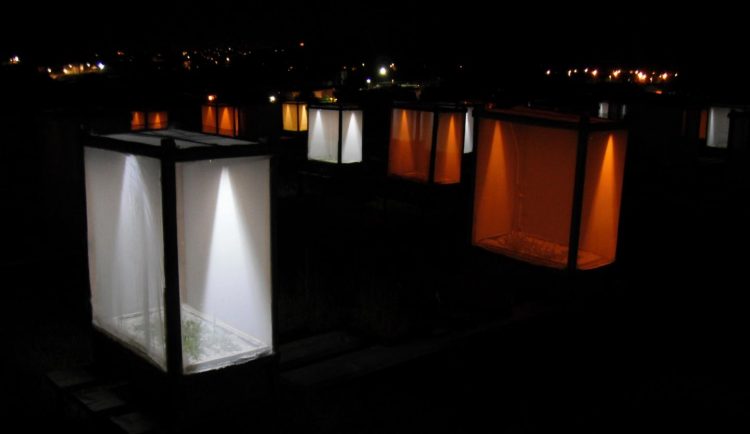Light pollution shown to affect plant growth and food webs

Researchers from the University of Exeter simulated the effects of street lighting on artificial grassland plots containing a community of invertebrates at night, exposing them to two different types of light treatment - a 'white' light similar to newer commercial LED street lighting systems and an 'amber' light simulating the type of sodium street lamp still found in much of the UK. The experiments investigated both top-down (driven by predators) and bottom-up (food or resource limited) effects of the lights on the population density of a species of pea aphid, and in the presence and absence of predators including ladybirds Credit: Jon Bennie/University of Exeter
The research shows that light pollution can impact the natural environment in complex ways that may be hard to predict. Due to the global extent of artificial light at night, there are concerns that these ecological impacts may be widespread.
Researchers from the University of Exeter simulated the effects of street lighting on artificial grassland plots containing a community of invertebrates at night, exposing them to two different types of light treatment – a 'white' light similar to newer commercial LED street lighting systems and an 'amber' light simulating the type of sodium street lamp still found in much of the UK.
The experiments investigated both top-down (driven by predators) and bottom-up (food or resource limited) effects of the lights on the population density of a species of pea aphid, and in the presence and absence of predators including ladybirds.
The low intensity amber light was shown to inhibit, rather than induce, flowering in greater bird's foot trefoil, a wild relative of peas and beans that is a key source of food for the pea aphid in grasslands and road verges. In mid summer aphids feed on the flowering shoots; the number of aphids was significantly suppressed under the light treatment in mid-August due to the limited amount of food available.
Professor Kevin Gaston, Director of the Environment and Sustainability Institute (ESI) said: “These are the first findings from major long-term experiments being funded by the European Research Council, and already reveal how profound the impacts of artificial night time lighting can be on even simple communities of organisms.”
Dr Jonathan Bennie of the ESI added: “Our results suggest that by lighting up our night time environment we trigger complex effects on natural food webs. While we are all aware that street lights often attract insects at night, we show that they may have more permanent, widespread impacts on wildlife and ecosystems.”
###
'Cascading effects of artificial light at night: resource-mediated control of herbivores in a grassland ecosystem' by Jonathan Bennie, Thomas W. Davies, David Cruse, Richard Inger and Kevin J. Gaston is published in the journal Philosophical Transactions of the Royal Society B.
The paper is part of a special themed issue of the journal entitled 'The biological impacts of artificial light at night: from molecules to communities', organised and edited by Kevin Gaston, Marcel Visser and Franz Hölker.
Media Contact
All latest news from the category: Life Sciences and Chemistry
Articles and reports from the Life Sciences and chemistry area deal with applied and basic research into modern biology, chemistry and human medicine.
Valuable information can be found on a range of life sciences fields including bacteriology, biochemistry, bionics, bioinformatics, biophysics, biotechnology, genetics, geobotany, human biology, marine biology, microbiology, molecular biology, cellular biology, zoology, bioinorganic chemistry, microchemistry and environmental chemistry.
Newest articles

A universal framework for spatial biology
SpatialData is a freely accessible tool to unify and integrate data from different omics technologies accounting for spatial information, which can provide holistic insights into health and disease. Biological processes…

How complex biological processes arise
A $20 million grant from the U.S. National Science Foundation (NSF) will support the establishment and operation of the National Synthesis Center for Emergence in the Molecular and Cellular Sciences (NCEMS) at…

Airborne single-photon lidar system achieves high-resolution 3D imaging
Compact, low-power system opens doors for photon-efficient drone and satellite-based environmental monitoring and mapping. Researchers have developed a compact and lightweight single-photon airborne lidar system that can acquire high-resolution 3D…





















